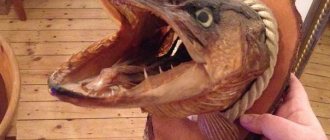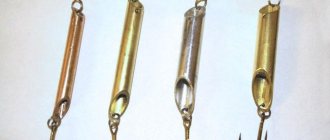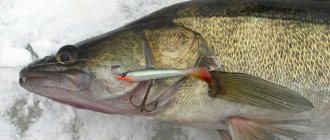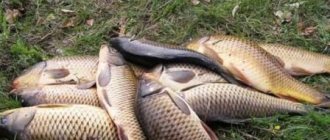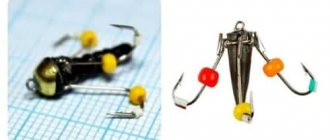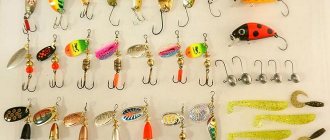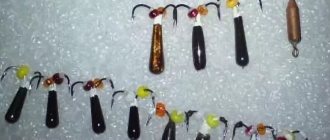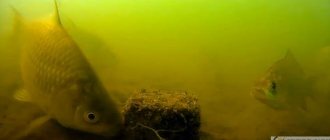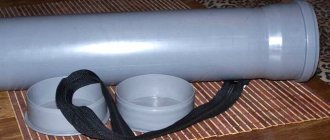Fishing gear are items that allow you to catch certain fish in a certain body of water. There are a lot of varieties of them. Some gear is used by beginner fishermen, others by experienced professionals.
For each of them there is a special technique or fishing scheme. Fishermen always recommend trying each of them to learn the specifics of fishing. What is Mandula fishing? Read on.
Features of fishing with mandula
Fishing for pike perch
- To catch pike perch, use a two-piece or three-piece bait.
- Its dimensions should be within 7-10 centimeters.
- The weight of the attached load is from 10 to 50 grams.
- It is not recommended to use lightweight tackle; the opposite is better.
- It is better to use very sharp, triple hooks.
- The blade of the hook should be placed at a distance of half a centimeter from the body of the bait.
- When fishing, you need to take several specimens of the mandula, as there is a possibility of losing the gear.
Pike fishing
- The tackle here should be made up of several elements (3-4).
- You can use any shape: square; barrel; ball.
- The size of the tackle should be between 9 and 11 centimeters.
- The length of the gear can be no more than 15 centimeters.
- A size from 7 to 9 centimeters can be used only when it is known for sure that there is no possibility of catching large individuals in the reservoir.
- It is recommended to choose a varied, variegated coloring. These are: orange; red; white; green; blue; blue.
- You can hang a small bright brush made of threads at the end of the tackle. In the water it will move and attract attention.
- The fishing distance should not be more than 40 meters.
- The weight of the cargo is within 10-25 grams.
Perch fishing
When fishing for perch, mandules with the following characteristics are used:
- length up to 5 centimeters;
- body of 3-4 parts of bright colors;
- load no more than 14-15 grams;
- most suitable for light and ultra-light spinning rods;
- Best used in open water;
- a special carabiner is attached to the fishing line;
- at the end there should be a bright tail of threads.
Let's celebrate! With such tackle you can catch both large and medium-sized specimens.
It is necessary to take several options of different colors to determine the preferences of the fish. Perch is excellently caught in the bottom layer with a small current.
Installation of equipment
Installation of the diverter leash is carried out at home or directly while fishing. There are several options, I’ll tell you about the one that, in my opinion, is more convenient than others.
We take two pieces of fishing line and make a loop at one end of both. To the longer one (about a meter) we attach an offset hook to the free end of the fishing line. We tie a weight to the end of the second leash (about 30 centimeters). Now you have two ready-made leashes, which all you have to do is attach them to the main fishing line (in my case, a braided cord). For these purposes, I attach a carabiner with a swivel to the cord, onto which I attach the leashes to the loops.
Recommended reading: How to catch pike perch using a spinning rod
This installation is quite simple. If necessary, it allows you to quickly switch to other equipment.
The weight for the diversion is used in different shapes, the color does not matter. The ballerina load has proven itself well. This simple invention significantly reduces the number of “dead” holds. This is especially felt on a rocky bottom when fishing from the shore.
The length and diameter of the fishing line can vary, depending on the activity and size of the intended prey. A thick line impairs the performance of the bait; too thin a line can lead to breakage; a compromise must be sought.
Blind installation using a triple swivel also does not take much time, but it complicates the scheme a little. We take a swivel, tie the leashes to a short weight, which we select according to the fishing conditions. All that remains is to attach the hook to the attached, longer leash.
Wiring technique

In still water
- Here you need to know what season and in what places pike, pike perch or perch are found. The best time of the year is autumn.
- It is recommended to fish on edges, slopes or uneven areas - favorite places for these types of fish.
- If long casts are used, then a heavier load is used.
- The tackle must be lowered to the bottom (the bottom must be examined first) and the tip of the rod lightly tugged.
- The predator will see the play of the bait and instinct will work, which will push the fish to attack.
In places with current
- Eyebrows are ideal places for such postings.
- Various loads and shapes are of great importance in this type of fishing.
- The bait must be lowered to the bottom and the lowering time must be calculated.
- Then you need to make a winding of 1.5-2 turns and pause.
- It is not recommended to take long pauses, as such actions by the fisherman will reduce the chances of catching fish.
Briefly about the gear
To fish for passive pike perch, for which the mandula is essentially intended, you will need a sensitive spinning rod. The fanged one can take the bait too gently, so it is important to feel any touch.
The rod test must correspond to the weight of the bait, usually not exceeding 20 g. The recommended test range is from 5 to 21 g. For fishing for pike perch, this spinning rod is ideal.
It is tough enough to pierce the pike perch’s mouth when hooking, and at the same time very sensitive, transmitting the contact of the bait with the fish both tactilely (in the hand) and visually (with the playing tip).
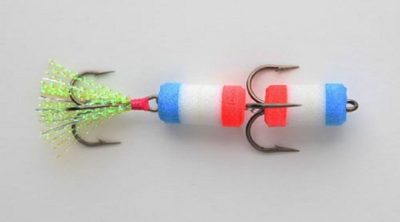
Since you will have to work with small masses, it is better to use monofilament or braid as thin as possible. The thinner the line, the farther the light bait flies. When fishing for pike perch, long casting is perhaps the most important condition.
The large weight of the head weight for a mandula is not as critical as when fishing with foam rubber or silicone fish. Even an excessively heavy weight will not affect its performance in any way, but will significantly increase the casting distance.
Tackle for fishing with mandula
The mandula is a simple structure consisting of several parts. The main parts are made of polystyrene foam or expanded polystyrene. The foam is cut out in the form of cones and fastened with wire or metal rings.
Thick wires or tees pass through such cones, tightly attached to the material. The final element is the load. It is usually made from lead. This design can be done independently.
When using such fishing gear you need to know:
- The speed of lowering the mandula to the bottom of the reservoir;
- The spinning rod should have a length of 2.4 to 3.2 meters;
- The reel with fishing line must be high-speed;
- The size of the mandula depends on the fish (usually up to 5 centimeters or up to 12 centimeters).
In terms of its qualities, it can completely replace branded wobblers. Large and predatory fish bite on such bait.
Types of postings
In general, in order to hone the technique of fishing with a retractable leash, it would be good to go to any body of water where a predator, even a small one, often bites. This will instantly give you confidence in the tackle and allow you to understand what the fish like best.
The wiring methods are the same as most other leash rigs. Stepped, stop and go - reeling in the reel and regular pauses during retrieving, sometimes up to 10 seconds. More often the bite occurs during a pause, especially when the fish is inactive. Dragging along the bottom is a slow, even unwinding of the fishing line. More suitable for searching for fish, or when fishing by trolling, in which long distances are combed. If you get caught frequently, a ballerina will help.
Dash-and-dotted animation - again, we rotate the reel evenly and constantly make slight twitches with the tip of the spinning rod. Aggressive jerking - the same reeling only a little faster and sharp jerks with the rod, if fishing conditions allow. It is useful to alternate with pauses. Often this provokes even a passive predator.
Separately, we can highlight the wiring of various crustaceans and cuttlefish. In nature, these creatures rarely move quickly, but mostly just crawl. Based on this, you need to lead such a bait slowly. Slow dragging along the bottom with obligatory pauses works well. Naturally, such fishing is more suitable for inactive fish.
We recommend reading: Winter fishing for bream on a float
How to make a mandula with your own hands?
The advantage of making fishing tackle at home is the material that can be used in almost any way (from a rug to old shoes), which is painted in bright colors that imitate live fish.
In Russia, predators do not bite on brightly colored fish, which means the bait must be made in accordance with the preferences of aquatic inhabitants (predators).
The bait has excellent buoyancy due to the lightness of the material. It always remains in sight, since bodies of water must be chosen (preferably) with a clean bottom and clear water.
Making a mandula involves several stages and does not take much time:
- Cut the foam into squares or small bars, paint them in different colors with waterproof paint;
- All protruding ends and corners must be trimmed and rounded, glued together;
- Then, with a heated awl, you need to burn through all the bars from the inside, thereby making passages in them;
- Using a stationery knife, you need to give the bars a symmetrical and aesthetic appearance (this gives a natural look to the product);
- Pass a cotton swab through one bar;
- Take a piece of wire and make a loop at one end, and attach a hook to the other end;
- Using glue and foam blocks, assemble the structure by threading the hook through the block along with the wire, as well as fixing them with loops and glue;
- You need to make a fly from red thread;
- Secure the structure and check for strength;
- The product is ready for use on the pond.
Required tools and materials
The following materials are used to make bait:
- Double or triple hooks;
- Polystyrene foam or polystyrene foam;
- Wire with a diameter of up to 0.8 millimeters;
- Cotton buds;
- Pliers;
- Pliers and tweezers;
- Awl and thick thread;
- Red wool thread;
- Universal waterproof glue;
- Stationery knife.
DIY pike perch mandula

You can make it yourself from available materials. Homemade bait is not inferior to store-bought bait in terms of catchability, while significantly benefiting in price.
Classic mandula

Materials and tools
To make a mandula you will need the following materials:
- multi-colored flexible curlers or a small sheet of polyurethane;
- stainless steel wire with a diameter of 0.7-1.0 mm;
- steel binding wire;
- winding rings;
- two tees No. 2/0 and 3;
- Lurex or wool thread for the edge of the tail;
- waterproof glue “Moment-1”.
In the process of making bait you will need the following tools:
- sharp stationery knife or scissors;
- round nose pliers;
- wire cutters;
- pliers;
- sandpaper.
Recommended reading: How to catch an asp using live bait
Reviews from fishermen
The thing is interesting, convenient and effective. It is necessary to walk towards a predator. I agree with my comrades who say that knowledge in the field of fishing is necessary to get a good result. Since this gear will be completely useless if there is a small and narrow body of water with a small amount of fish, to which several fishermen come every day. You can sit here day and night and waste your time. Grade:
Mikhail, 35 years old
The thing is excellent, especially for a predator. I fished all summer and used various gear on the local reservoir. The catch was small (small pond), but the experience was good. You also need to know about complementary feeding and fish habits - this will be a huge plus. Grade:
Pavel, 45 years old
I recommend that novice fishermen try new gear and techniques for different fish and in different bodies of water. Only experience makes it possible to get the maximum benefit from every fishing trip. Here gear plays a secondary role. Grade:
Fedor, 56 years old
I have never used such a thing when fishing. I read the reviews - they say it’s worth a try. Now I’m thinking whether to buy it in a store or make it myself. I'll definitely try it. Grade:
Kirill, 29 years old
I make all my fishing gear myself. Sometimes you have to spend a little time in order to enjoy looking at a wonderful catch later. The mandula is made quickly, no special skills are needed. There are many useful sites on the Internet where they teach how to perform such gear with clear examples. I tried to use this gear while fishing, it was very interesting. I recommend that my friends try it too. Grade:
Nikita, 38 years old
According to fishermen, this device is very effective. It is already used by experienced fishermen. Numerous hooks help to catch a cunning predator (pike perch or pike).
The positive aspects here are the opportunity not only to purchase a mandula in a store, but also to make it yourself using available materials. This is an excellent and functional device that will definitely come in handy when fishing.
Wiring types
In order to achieve good results when using a mandula, it is worth carefully studying the types of wiring. It can be:
- classic “step”;
- drawing;
- tosses.
The classic “step” works great in any fishing season and provides active bites.
Dragging is effective in reservoirs where there are sharp drops to depth. This method is especially relevant during times of low feeding activity of the predator.
When pike perch are hungry in the fall, it is effective to use the tossing technique. This way the mandula creates significant oscillatory movements and attracts fish.
Bait selection
Diversion baits can be quite varied.
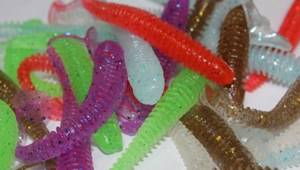
Silicone baits for lead rigs
The most common of them are twisters, vibrotails, slugs, silicone worms, cuttlefish and crustaceans. “Edible rubber” enhances catchability. These are the same silicone baits impregnated with a special attractant. Baits often contain salt and flavoring additives, so the fish can hold it in their mouth for a long time and even try to swallow this imitation of natural food.
The offset bait is selected in such a size that the mounted bait, for example a twister, does not spin when moving around its axis. To do this, either take a larger hook, or lightly load the hook from below.
Retractable leash with wobbler
You can also fish with floating, quickly pop-up wobblers, but you should not use those that have a large depth due to a long blade, otherwise there will be frequent snags resulting in loss or breakage of the wobbler.
We recommend reading: Tackle for carp fishing: (best equipment and rigs)
Mandula on a retractable leash
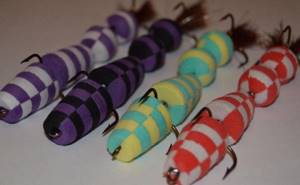
The mandula bait has positive buoyancy. Please note that during pauses it will rise up. Some spinning anglers use a bait such as a mandula on a retractable leash. This is a kind of homemade composite wobbler, which is made from colored pieces of polyurethane, put on two tees, hooks are connected with winding rings. It looks like a bright, colorful fish with a twister or feather tail. In general, this bait is a jig bait. Using articulated jig rigs, pike perch and pike are caught on a mandula. However, due to its positive buoyancy, the motley bait can also be used in spaced rigs.
Mandula with and without propeller
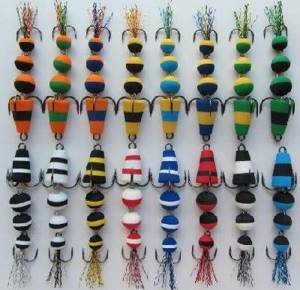
Mandula on pike (video)

An equally catchy homemade bait, as in the photo, is a foam fish, you can learn about making it in our article at the link: making a foam fish with your own hands.
Fishing with a mandula (video)
Author of the article: Vitaly Leonidovich Ivanov, 2021.

